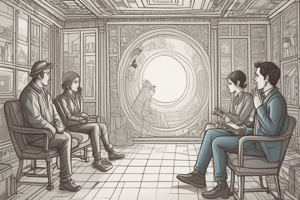Podcast
Questions and Answers
What percentage of all communication does nonverbal communication account for?
What percentage of all communication does nonverbal communication account for?
- 55-60%
- 45-50%
- 65-93% (correct)
- 80-90%
Which type of nonverbal communication involves the use of scents and smells?
Which type of nonverbal communication involves the use of scents and smells?
- Olfactics (correct)
- Paralinguistics
- Haptics
- Kinesics
What does a direct gaze typically indicate in nonverbal communication?
What does a direct gaze typically indicate in nonverbal communication?
- Boredom
- Fear
- Anger
- Interest and honesty (correct)
In which cultures is physical touch more common?
In which cultures is physical touch more common?
What does a genuine smile typically indicate in nonverbal communication?
What does a genuine smile typically indicate in nonverbal communication?
Which type of nonverbal communication involves the use of clothing, accessories, and personal items?
Which type of nonverbal communication involves the use of clothing, accessories, and personal items?
Flashcards are hidden until you start studying
Study Notes
Nonverbal Communication
Definition: Nonverbal communication refers to the process of conveying information and ideas through non-linguistic means, such as facial expressions, body language, tone of voice, and physical appearance.
Types of Nonverbal Communication:
- Kinesics: Body language, posture, and facial expressions
- Paralinguistics: Tone of voice, pitch, rate, and volume
- Proxemics: Personal space and physical distance
- Haptics: Touch and physical contact
- Artifacts: Clothing, accessories, and personal items
- Olfactics: Scents and smells
- Chronemics: Time and punctuality
Importance of Nonverbal Communication:
- Accounts for 65-93% of all communication
- Can convey emotions and attitudes more effectively than verbal communication
- Can reinforce or contradict verbal messages
- Plays a crucial role in building trust and establishing relationships
Nonverbal Cues:
- Eye Contact: Direct gaze indicates interest and honesty, while avoidance indicates dishonesty
- Smiling: A genuine smile indicates friendliness and approachability
- Posture: Open and relaxed posture indicates confidence, while closed and tense posture indicates defensiveness
- Touch: Physical touch can convey empathy, comfort, and affection
Cultural Differences in Nonverbal Communication:
- High-Context Cultures: Rely heavily on nonverbal cues, such as in Japan and Arab cultures
- Low-Context Cultures: Rely more on verbal communication, such as in the United States and Germany
- Cultural Variations in Touch: Physical touch is more common in some cultures, such as in Latin America, while it's more reserved in others, such as in Nordic countries
Studying That Suits You
Use AI to generate personalized quizzes and flashcards to suit your learning preferences.




